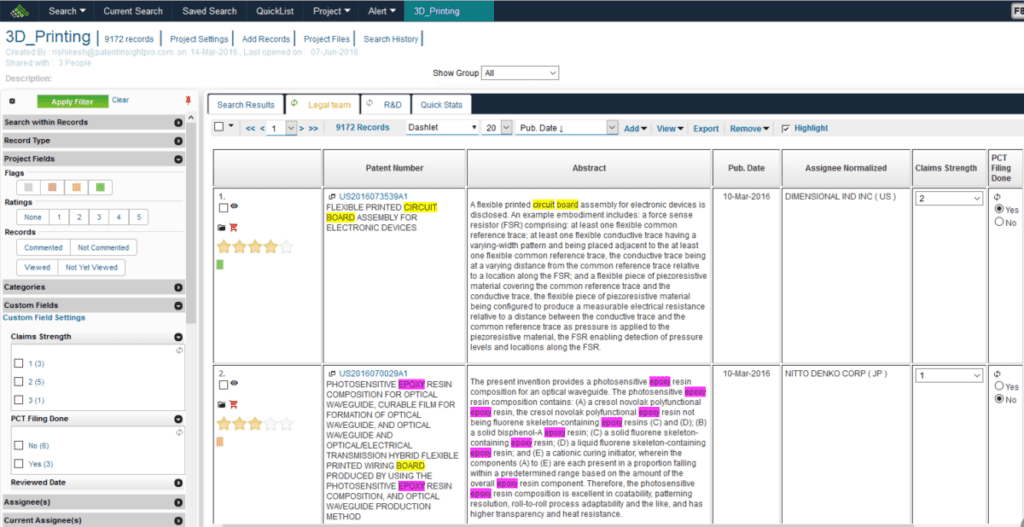Transforming Your Corporate Intellectual Property and Scientific Information Sharing and Collaboration
Share:
Management and Sharing of Patent and Scientific information is critical to research driven organizations where timely delivery of relevant information to researchers and other stakeholders requires help of dedicated information professionals. At any given time, information professionals in companies may have multiple projects ongoing across geographically dispersed teams with each project having its own data demands from Patent and Non-patent literature databases.
The Challenge
Much of the scientific/patent data in companies is delivered as Macro-enabled Excel or Word documents and too often such information is not centrally contained leading to information mismanagement. Some companies receive this data from external service providers but still fall prey to similar issues trying to manage all the different reports and data received. Trying to collaborate on Excel Sheets with 50+ columns over extended time periods lead to versioning issues and increase chances of data being overwritten and getting corrupted.
Traditional enterprise patent archives are designed to be a one-way delivery of information that leaves out any scope of gathering substantial input back from the end-user into the platform. They may not support non-patent literature which is equally critical for R&D users in innovation projects. Further, organizational data has grown beyond taxonomies and one-dimensional fields and in order to fit into more complex collaboration workflows, solutions must allow configuration of complex many-to-many multi-dimensional meta-data in easy to create customizable views similar to CRM or ERP systems.
Integrate IP information and keep it updated
The solution creates a centralized repository allowing you to manage all Patent and Non Patent Literature in context of ongoing projects. There is seamless integration of information coming in from multiple sources viz. PatSeer or third-party value-added databases, in-house archives and service providers.
Traditional enterprise patent archives are designed to be a one-way delivery of information that leaves out any scope of gathering substantial input back from the end-user into the platform. They may not support non-patent literature which is equally critical for R&D users in innovation projects. Further, organizational data has grown beyond taxonomies and one-dimensional fields and in order to fit into more complex collaboration workflows, solutions must allow configuration of complex many-to-many multi-dimensional meta-data in easy to create customizable views similar to CRM or ERP systems.

You no longer need to waste time and resources in keeping the stored information updated. All stored patent data is automatically updated with reclassification’s, reassignments or changes to legal status, families and citations so that the end user sees the correct information 5-6 months down the line too. The system allows access to printable translations, full-text, PDFs and drawings from PatSeer’s comprehensive global patent content. You can also integrate alerts coming from third-party databases and monitoring services service providers into projects and with inbuilt notifications the end users can access and manage all the new data in a automated and streamlined fashion.
Traditional enterprise patent archives are designed to be a one-way delivery of information that leaves out any scope of gathering substantial input back from the end-user into the platform. They may not support non-patent literature which is equally critical for R&D users in innovation projects. Further, organizational data has grown beyond taxonomies and one-dimensional fields and in order to fit into more complex collaboration workflows, solutions must allow configuration of complex many-to-many multi-dimensional meta-data in easy to create customizable views similar to CRM or ERP systems.
Capture Complex Organizational metadata that add relevance and context to the data
Create configurable metadata such as taxonomies, custom fields, tables and work flows as per project needs. The system includes powerful yet simple rating; flagging, multi-user commenting options and any number of custom fields and tables for records in a project can be enabled. Advanced custom fields such as drop downs, date, checkbox and tables make it possible to create intuitive ways to capture information that meets the most demanding patent workflows. Further, your clients can search, filter and analyze through the custom data just like other standard patent/non-patent data fields.
Simplified Collaboration and distribution of work without loss of control
A highly useful feature of PatSeer Projects is its permissions engine that gives you complete control of what to make visible, editable or shared. It controls the features and data in a Project via View, Read, Create, Edit, and Delete permission levels which you can set. Patent Dashlets® (Business Dashboards) can be created and shared as per requirement of the end user.




